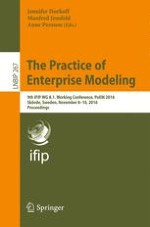
2016 | OriginalPaper | Buchkapitel
Establishing ‘Architectural Thinking’ in Organizations
verfasst von : Robert Winter
Erschienen in: The Practice of Enterprise Modeling
Aktivieren Sie unsere intelligente Suche, um passende Fachinhalte oder Patente zu finden.
Wählen Sie Textabschnitte aus um mit Künstlicher Intelligenz passenden Patente zu finden. powered by
Markieren Sie Textabschnitte, um KI-gestützt weitere passende Inhalte zu finden. powered by